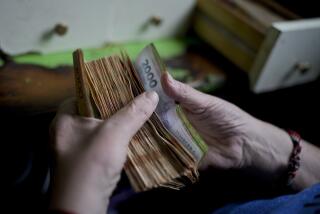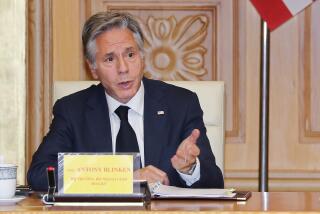Tehran calm but Iran merchants fear more currency turmoil
TEHRAN — The black-market money changers are lying low these days here in Iran’s capital, feeling the heat of a government that has singled them out for much of the blame in the free fall of the national currency, the rial.
“Money trading on the sidewalk has become like illicit drug trafficking,” one trader, Asghar, said Sunday in a small shop near the British Embassy. “But it will not remain so.” Asghar, like others interviewed, asked that his last name not be used, fearing arrest.
There have been no more protests since Wednesday’s unscripted march from the Grand Bazaar by hundreds of merchants, enraged about a currency that lost close to 40% of its value in a matter of days.
The demonstration was a bold statement from the beleaguered merchants, viewed as stalwarts of the government and a major force backing the 1979 Islamic Revolution. The cloth salesmen, gold sellers and others were furious at what they view as economic policies that have failed to protect the currency, playing havoc with the markets.
Police presence has been bolstered in the bazaar and at intersections favored by money changers, sending a message that further acts of public defiance will not be tolerated. The atmosphere at the bazaar this weekend was tense, though the hustle and bustle Sunday probably seemed normal from shoppers’ perspective.
On Thursday, the government announced the arrest of 16 unidentified “currency disturbers.” On Sunday, the Tehran public prosecutor’s office said the number had reached 30.
President Mahmoud Ahmadinejad, whom many merchants seem to blame for the crisis, has pointed the finger at 22 unnamed ringleaders, apparently currency manipulators, as well as the withering effects of U.S.-led economic sanctions meant to pressure Iran on its controversial nuclear program. Revenue from oil, the nation’s principal export, is said to be way down. The president has also lamented a “psychological war” that, in his view, seems to have contributed to a run on the rial and its abrupt drop.
This was not just a currency exchange issue, but one that affected pocketbooks: Prices of consumer goods and staples rose sharply with the exchange rate, further pinching middle- and working-class Iranians. People saw the value of their savings nose-dive with the currency.
International analysts warned of hyperinflation, a phenomenon known to topple governments. Iranians rushed to buy dollars, euros, gold — anything that seemed a stable investment.
The leadership took notice, dispatching police and cracking down on currency traders. At Friday’s Islamic prayers, there was a thinly veiled warning from a firebrand preacher, Ayatollah Ahmad Khatami.
“The merchants in the bazaar should not misuse their unity against people,” Khatami said, citing a Koranic script equating hoarding and disturbing the markets with “murdering a human being.”
A sense of cautious calm has returned to the bazaar and nearby streets, at least for now.
Officially sanctioned exchange shops were trading Sunday at the official rate, offering to buy greenbacks at about 28,000 rials to the dollar. There were few takers, in contrast to the frenzied pace of just a week ago. Consumers and traders alike seem to have little doubt that the rate will adjust to free-market demand in days or weeks, once official oversight lessens, triggering a new dash for dollars.
“Everyone expects another plunge,” said Hassan, a currency dealer. Few here seem to doubt it.
Mostaghim is a special correspondent. Times staff writer Patrick J. McDonnell in Beirut contributed to this report.
More to Read
Sign up for Essential California
The most important California stories and recommendations in your inbox every morning.
You may occasionally receive promotional content from the Los Angeles Times.










